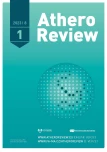How to make treatment faster than atherosclerosis
Authors:
Jan Piťha 1,2
Authors‘ workplace:
Kardiocentrum, Klinika kardiologie IKEM, Praha
1; Centrum experimentální medicíny, Laboratoř pro výzkum aterosklerózy IKEM, Praha
2
Published in:
AtheroRev 2023; 8(1): 32-37
Category:
Reviews
Overview
Advanced atherosclerotic changes can resist even very effective therapy. Therefore, to stop development of such changes at its beginning, it is intensively discussed less intensive, but early initiated pharmacotherapy. This treatment should be considered in men and women already of lower middle age with even moderately elevated values of atherogenic lipids and blood pressure, in which we are generally hesitating to start drug treatment. The first step is to select individuals who will very probably benefit from the treatment, the second step is to convince them that they should take the medicine at age when they feel no discomfort and no risk for developing cardiovascular disease. One solution is to start therapy with smaller doses of drugs that favorably affect blood pressure, the lipid spectrum or other metabolic parameters, optimally antihypertensive drug and statin in a fixed combination, in one tablet. This could achieve not only a significant reduction in the risk of drug side effects but could also simplify the treatment and, in general, to increase its acceptability. It is of importance to tell that these considerations do not in any way diminish the importance of healthy lifestyle. We will try to address this issue in the following overview.
Keywords:
hypertension – dyslipidemia – timing of treatment
Sources
1. Gidding SS, Colangelo LA, Nwabuo CC et al. PDAY risk score predicts cardiovascular events in young adults: the CARDIA study. Eur Heart J 2022; 43(30): 2892–2900. Dostupné z DOI: <http://dx.doi.org/10.1093/eurheartj/ ehac009>.
2. St Goar FG, Pinto FJ, Alderman EL et al. Detection of coronary atherosclerosis in young adult hearts using intravascular ultrasound. Circulation 1992; 86(3): 756–763. Dostupné z DOI: <http://dx.doi.org/10.1161/01. cir.86.3.756>.
3. Kannel WB, Schatzkin A. Sudden death: lessons from subsets in population studies. J Am Coll Cardiol 1985; 5(6 Suppl): 141B-149B. Dostupné z DOI: <http://dx.doi.org/10.1016/s0735–1097(85)80545–3>.
4. O’Donoghue ML, Giugliano RP, Wiviott SD et al. Long-Term Evolocumab in Patients with Established Atherosclerotic Cardiovascular Disease. Circulation 2022; 146(15): 1109–1119. Dostupné z DOI: <http://dx.doi. org/10.1161/CIRCULATIONAHA.122.061620>.
5. Shapiro MD. Prolonged and Pronounced Low-Density Lipoprotein Cholesterol Lowering: The Gift That Keeps Giving. Circulation 2022; 146(15): 1120–1122. Dostupné z DOI: <http://dx.doi.org/10.1161/CIRCULATIONAHA. 122.061727>.
6. Hemkens LG, Ewald H, Gloy VL et al. Colchicine for prevention of cardiovascular events. Cochrane Database Syst Rev 2016; 2016(1): CD011047. Dostupné z DOI: <http://dx.doi.org/10.1002/14651858.CD011047.pub2>.
7. Kronenberg F, Mora S, Stroes ES et al. Lipoprotein(a) in atherosclerotic cardiovascular disease and aortic stenosis: a European Atherosclerosis Society consensus statement. Eur Heart J 2022; 43(39): 3925–3946. Dostupné z DOI: <http://dx.doi.org/10.1093/eurheartj/ehac361>.
8. Warden BA, Fazio S, Shapiro MD. The PCSK9 revolution: Current status, controversies, and future directions. Trends Cardiovasc Med 2020; 30(3): 179–185. Dostupné z DOI: <http://dx.doi.org/10.1016/j.tcm.2019.05.007>.
9. Miller VM, Naftolin F, Asthana S et al. The Kronos Early Estrogen Prevention Study (KEEPS): what have we learned? Menopause 2019; 26(9): 1071–1084. Dostupné z DOI: <http://dx.doi.org/10.1097/ GME.0000000000001326>.
10. Matthews KA, El Khoudary SR, Brooks MM et al. Lipid Changes Around the Final Menstrual Period Predict Carotid Subclinical Disease in Postmenopausal Women. Stroke 2017; 48(1): 70–76. Dostupné z DOI: <http:// dx.doi.org/10.1161/STROKEAHA.116.014743>.
11. Pitha J, Králová-Lesná I, Sekerková A et al. Menopausal transition enhances the atherogenic risk of smoking in middle aged women. Int J Cardiol 2013; 168(1): 190–196. Dostupné z DOI: <http://dx.doi.org/10.1016/j. ijcard.2012.09.095>.
12. Rose G. ABC of vascular diseases. Epidemiology of atherosclerosis. BMJ 1991; 303(6816): 1537–1539. Dostupné z DOI: <http://dx.doi.org/10.1136/ bmj.303.6816.1537>.
13. Triggle CR, Mohammed I, Bshesh K et al. Metformin: Is it a drug for all reasons and diseases? Metabolism 2022; 133: 155223. Dostupné z DOI: <http://dx.doi.org/10.1016/j.metabol.2022.155223Z>.
Labels
Angiology Diabetology Internal medicine Cardiology General practitioner for adultsArticle was published in
Athero Review

2023 Issue 1
Most read in this issue
- How to make treatment faster than atherosclerosis
- Cardiovascular risk: from meaning to determination to communication with the patient
- Lipitension: new options of combination therapy
- The 95th percentile of LDL-cholesterol in the Czech population: The Czech post- MONICA study
